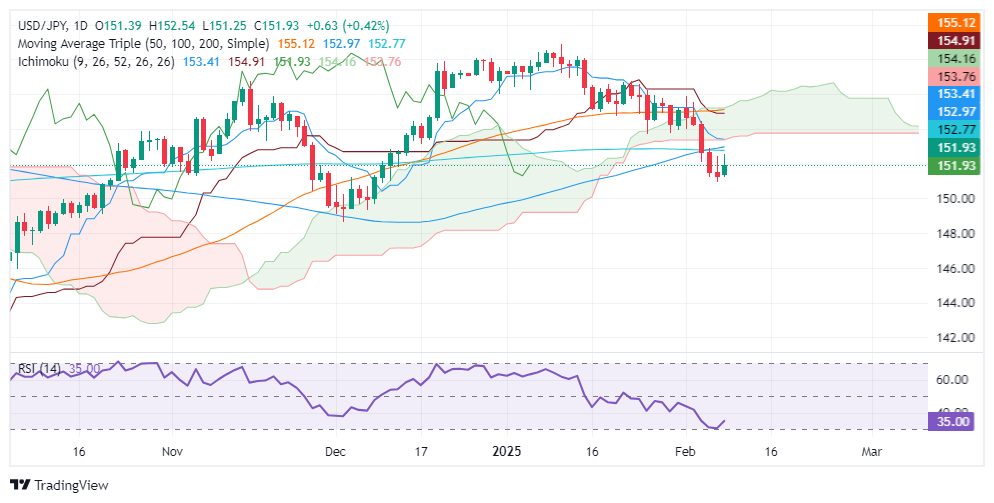USD/JPY Price Forecast: Recovers but fails at 152.00, bears lurk
- USD/JPY up 0.39%, still below key 152.00 level amidst ongoing bearish momentum.
- Technical indicators point to downtrend; pair below 200-day SMA and Ichimoku Cloud.
- Key supports at 150.00 and 148.64; breaching these could lead to significant downside.
The USD/JPY recovered some ground on Monday and finished the session on a higher note, registering gains of 0.39% but closing below the 152.00 figure. As Tuesday’s Asian session begins, the pair is virtually unchanged, but set to extend its losses as bulls failed to reclaim the 200-day Simple Moving Average (SMA) at 152.76
USD/JPY Price Forecast: Technical outlook
The USD/JPY downtrend remains after tumbling below the 200-day SMA and the Ichimoku Cloud (Kumo). Monday’s price action registered a daily high at 152.53 before slumping below the 152.00 mark, opening the door for further downside.
Momentum remains bearish, as the Relative Strength Index (RSI) depicts. Therefore, the USD/JPY might extend its losses.
The first support would be the 150.00 figure. A breach of the latter will expose the December 3 latest cycle low of 148.64, followed by the September 30 at 141.65.
However, if buyers reclaim 152.00, they must drive the USD/JPY above the 200-day SMA and the 153.00 mark.
USD/JPY Price Chart – Daily
Japanese Yen FAQs
The Japanese Yen (JPY) is one of the world’s most traded currencies. Its value is broadly determined by the performance of the Japanese economy, but more specifically by the Bank of Japan’s policy, the differential between Japanese and US bond yields, or risk sentiment among traders, among other factors.
One of the Bank of Japan’s mandates is currency control, so its moves are key for the Yen. The BoJ has directly intervened in currency markets sometimes, generally to lower the value of the Yen, although it refrains from doing it often due to political concerns of its main trading partners. The BoJ ultra-loose monetary policy between 2013 and 2024 caused the Yen to depreciate against its main currency peers due to an increasing policy divergence between the Bank of Japan and other main central banks. More recently, the gradually unwinding of this ultra-loose policy has given some support to the Yen.
Over the last decade, the BoJ’s stance of sticking to ultra-loose monetary policy has led to a widening policy divergence with other central banks, particularly with the US Federal Reserve. This supported a widening of the differential between the 10-year US and Japanese bonds, which favored the US Dollar against the Japanese Yen. The BoJ decision in 2024 to gradually abandon the ultra-loose policy, coupled with interest-rate cuts in other major central banks, is narrowing this differential.
The Japanese Yen is often seen as a safe-haven investment. This means that in times of market stress, investors are more likely to put their money in the Japanese currency due to its supposed reliability and stability. Turbulent times are likely to strengthen the Yen’s value against other currencies seen as more risky to invest in.

